You’ve got an idea for great software, you’ve assembled the team, secured the funding, and now you’re ready to start coding.
But hold your horses! Your project will be much more successful if you write a technical specification first.
This type of document is like a roadmap you can follow while building your product.
Now, we know that jumping straight to code sounds attractive, but the benefits of preparing a technical specification are too significant to ignore.
In this article, we’ll see what a technical specification entails, how projects benefit from writing one, and how you can create yours. So, let’s dive in.
What Is a Technical Specification Document?
A technical specification is a document that outlines the requirements and features that a product has to have in order to work as intended.
It’s usually designed as a comprehensive document containing the details on how to create these features, such as information about the product design and technical development, and it is part of writing software documentation.
To put it plainly, technical specifications describe what the product will do and how the development team will achieve that.
In case the terms features and requirements sound too ambiguous, we’ll list some of the main points that technical specifications aim to address. These are:
- Product abilities and limitations
- The purpose of the project
- Development milestones
- Security and privacy measures
- Measuring impact
- The planned timeline
Although the points listed above may resemble something you’d find in marketing materials, technical specifications are designed primarily for internal use.
After the development team lead and software architect design the product specification, project managers, developers, and quality assurance specialists use the document as a reference throughout the entire development process.
However, the technical specification is more than a blueprint for the project. Keep reading to learn more about the benefits a tech spec brings to software teams.
Why Is It Important to Write a Technical Specification?
If you write a good technical specification before the development phase begins, your team will have a clear-cut plan of work, and the stakeholders will be able to form realistic expectations—that’s a win-win situation.
Software development is an innately risky business. And according to Joel Spolsky, founder of Trello, operating without a technical specification makes it even riskier.
“Failing to write a spec is the single biggest unnecessary risk you take in a software project. It’s as stupid as setting off to cross the Mojave desert with just the clothes on your back, hoping to ‘wing it.’”
So, if you don’t want unexpected setbacks hindering your developers’ progress, it’s best to spell out the elements of the project ahead of time.
Say you were building a website where the users must register.
In that case, you wouldn’t be able to start writing code for registration, forgotten passwords, or anything else without the actual words that would appear on the screen.
That’s precisely why Spolsky encourages writing technical specifications. Here’s his example of a login screen filled with actual content.
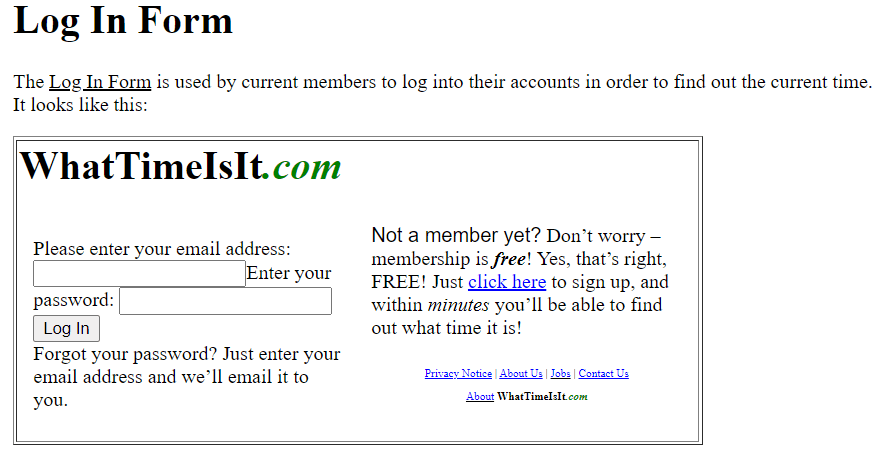
Source: Joel Spolsky
If your technical specification outlines the exact parts of your solution, your team doesn’t have to deal with making decisions on the spot, minimizing the risks that come with wrong or rushed decisions.
Similarly, having a defined vision of the product keeps all stakeholders, including the clients, well-informed.
When your tech specification lays out what the product isn’t designed to do, nobody can complain about a lack of a feature that was never supposed to be there.
Lastly, technical specifications are also beneficial for project management.
Tracking the project’s progress and comparing it to the timeline proposed in the specification helps you allocate the resources more effectively and adjust the pace of work as needed.
Essentially, a technical specification may be a single document, but it’s a mighty one because it brings benefits to multiple parties involved in the product.
What to Do Before Writing Technical Specifications
Has reading about the benefits inspired you to start working on the technical specification for your next product? If that’s the case, excellent!
There are just a few more things you need to define before you dive into listing features and naming endpoints.
To create an effective technical specification, you first have to determine its purpose.
When the backend developer Della Anjeh worked with technical specifications at Lyft, she learned that only well-thought-out specifications bring value to the development process.
Anjeh even calls technical specifications without a purpose “a waste of time” and advises asking the following questions before writing the document:
“What do I hope to achieve through this tech spec?”
Answering that question will give you a direction for building the document.
For instance, if you want your technical specification to bring uniformity to the development process, you know you’ll have to dedicate a fair portion of the document to listing the exact field or endpoint names.
Anjeh’s table below shows some more examples of what the purpose of a technical specification can be and how it controls the direction of the document.
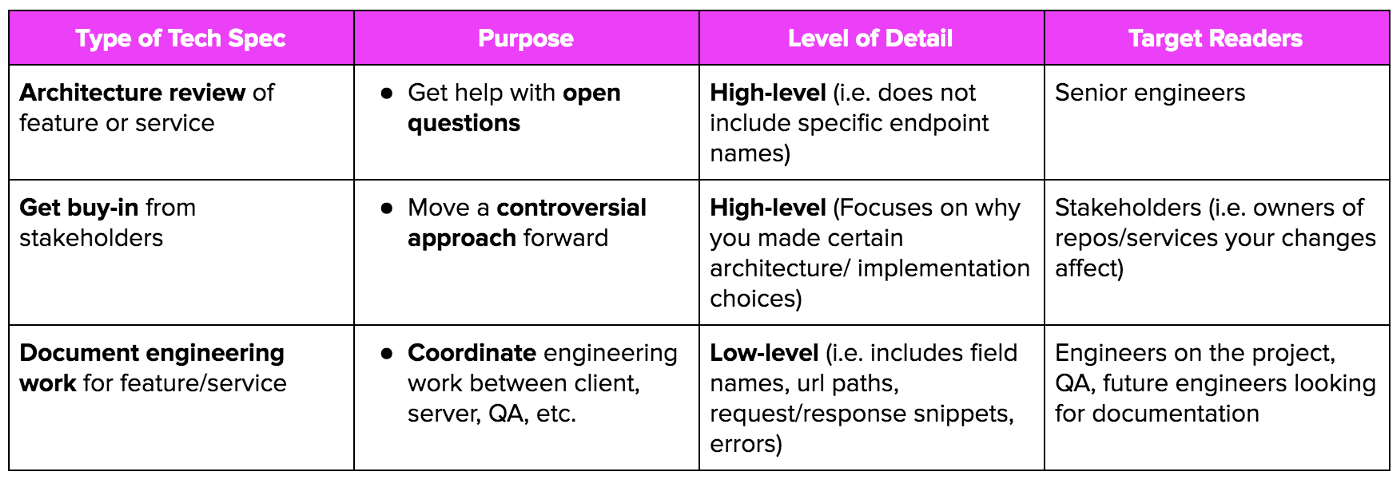
Source: Medium
Furthermore, it’s also helpful to restate the value proposition of the product itself. This will help you contextualize the document you’re about to write.
At this point, it’s not yet necessary to get into the details of how your software will work—there’s room for that once you start writing the specification.
Instead, you should explain what the goals of your product are, as advised by Brad Bjorndahl, an experienced technical writer.
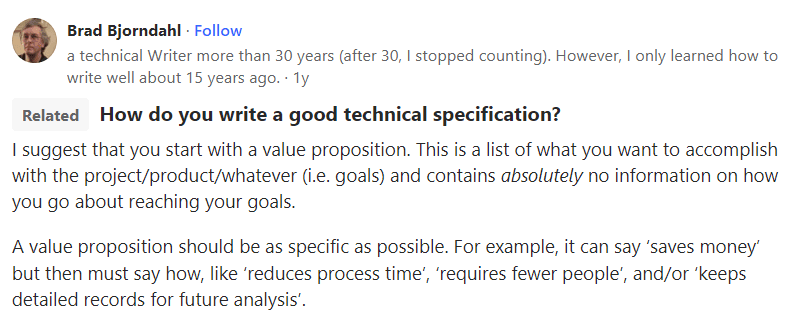
Source: Quora
When you verbalize what your product is aiming to achieve, you’ll have an outline for writing a technical specification.
Once you’ve done these preparatory steps, it’s time to decide what to include in your technical specification, which is our next topic.
What does a technical specification document contain?
A technical specification document typically contains information about the requirements, specifications, and functionalities of a product or project. It may include sections on project scope, requirements gathering, design specifications, system architecture, testing criteria, and other relevant information. The technical specification should accurately reflect the requirements and specifications of the project and provide detailed information about the system or software being developed.
If you want an informative technical specification that’s also easy to navigate, you need a reliable document structure.
We’ll outline an effective format based on how engineers organize technical specifications at Lyft, but we encourage you to adjust the format to fit your products’ needs better.
Introduction
Like any other piece of technical writing, tech specifications should start with an introduction or an abstract presenting the product. Here’s the one written for the OAuth 2.0 protocol.
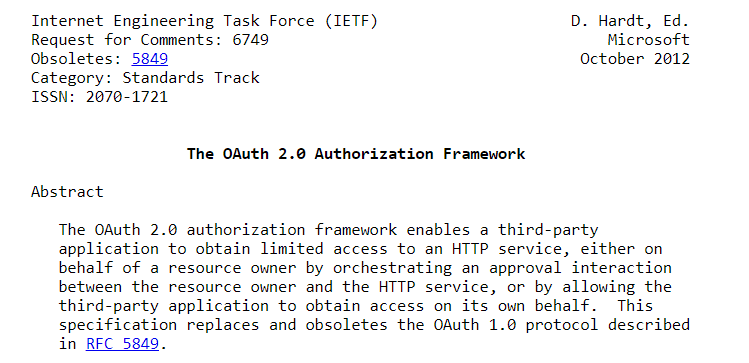
Source: IETF Datatracker
That introduction gives the reader an overview of what lies ahead, making it easier to find their way around the rest of the document.
Background
After you’ve briefly described what the product does, the next element should be the product’s background.
The background section should cover the context and the motivation behind the product.
You can also use this section to state how your solution differs from the competition and mention the previous attempts that have been made to solve the problem you’re tackling.
Goals and non-goals
In addition to describing what your product will do, it’s also helpful to define what problems you aren’t setting out to solve. That’s why the next sections should be goals and non-goals.
For instance, Archbee, our documentation platform, is designed to help teams create product documents collaboratively.
However, our platform doesn’t intend to replace emails or Slack—and that’s an example of a non-goal.
Plan
The plan is the longest section of the specification. It describes the engineering approach and architectural solutions.
Flowcharts and diagrams are helpful visual tools you can use here to demonstrate the relationship between the product’s components.
Security, privacy, risks
If you want to ensure smooth sailing during the development, you should think of potential hindrances.
Your technical specification should cover the possible risks and actions you can take to prevent them, as seen in the following example.
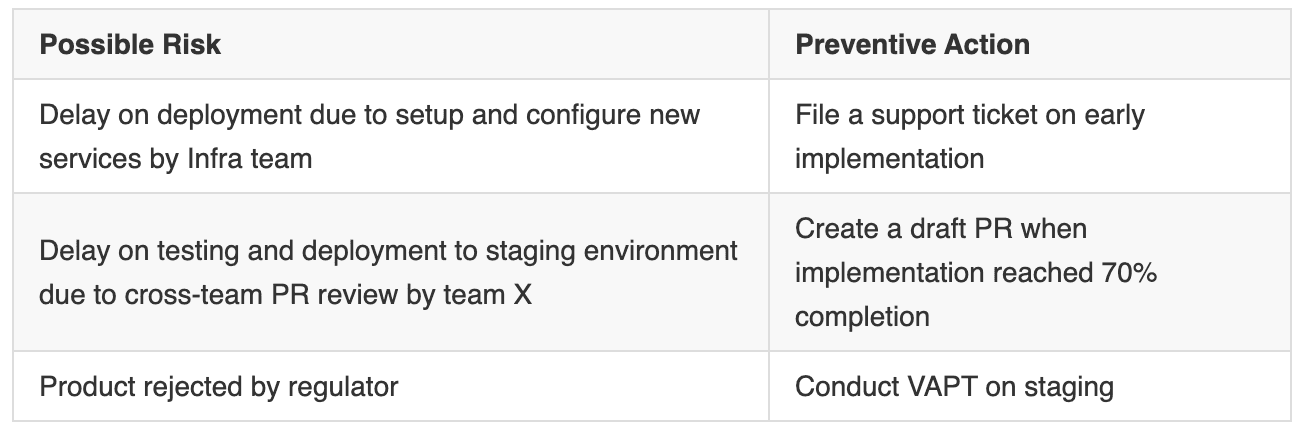
Source: Medium
And if you’re building an external-facing product, this is also the section to describe how you’ll ensure the privacy and security of all user data, so that the clients are risk-free as well.
Measuring impact
It’s vital to define how you’ll measure the success of your product before you start building it.
You should incorporate your selected metrics and the expected results in the technical specification so that you can later compare the actual performance to the expected one.
Milestones
Lastly, you need deadlines to keep your production organized. Your technical specification should contain the information on what parts of the product should be done by when.
That’s quite a list, right?
Luckily, a good documentation platform, like Archbee, can help you cover all the information you need and provides a specification template to get started.
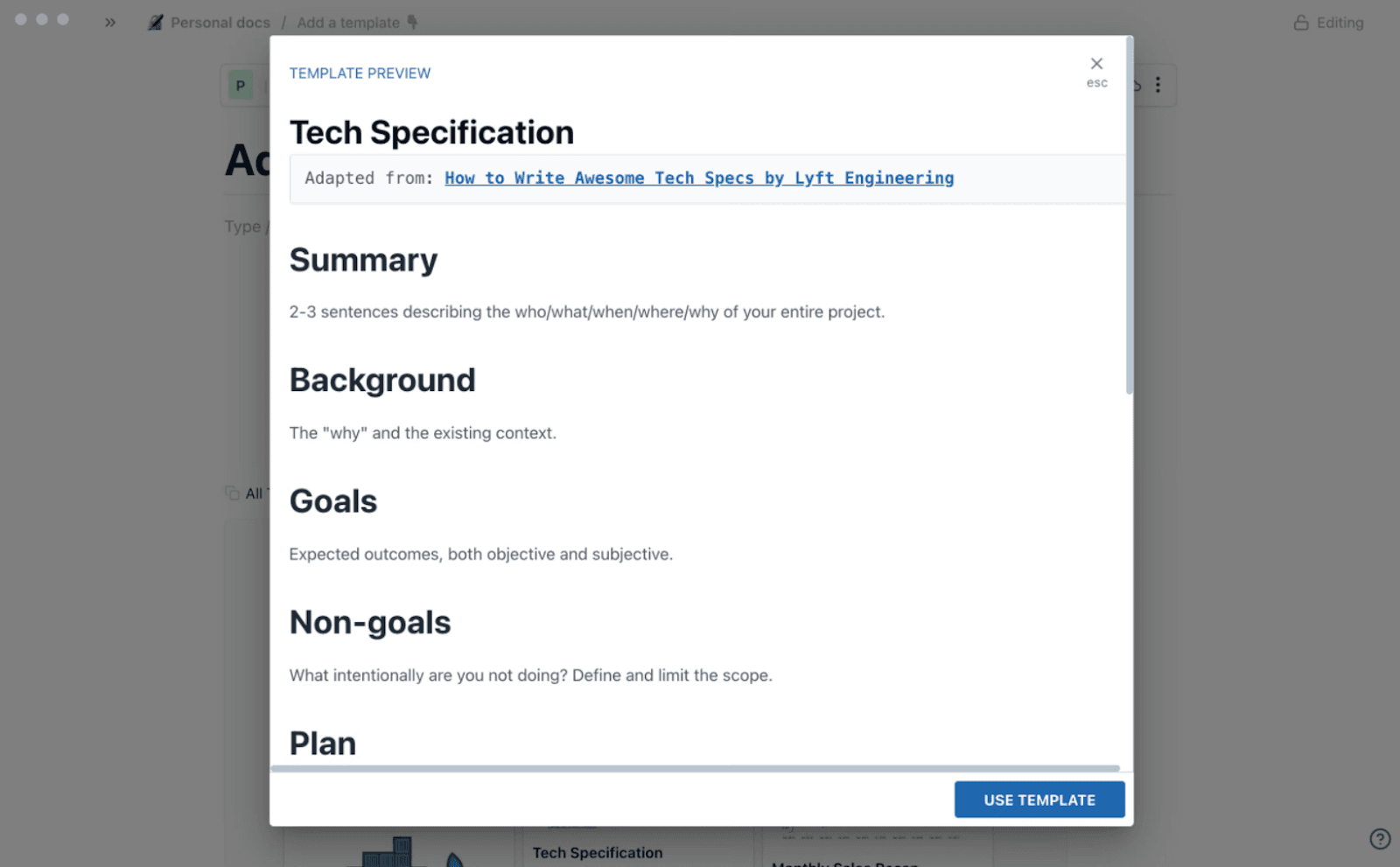
Source: docs.archbee.com
We already have a technical specification template available; it’s there to help you streamline the writing process.
And if the template doesn’t match your requirements completely, you can tailor it further.
Once you’re satisfied with how the technical specification looks, you can reuse the template for future projects.
How do you write a technical specification?
Now that you know why product specs are important and what they should contain, it’s time to learn how to write a technical specification that’s clear and easy to understand.
Here are the best practices for writing tech specs. It involves several key steps:
- You need to define the scope of the project and gather requirements from stakeholders
- Create an outline or structure for the technical specification document.
- Start writing the technical specifications, including details about the system or software being developed, technical requirements, system architecture, testing criteria, and other relevant information.
- Review and make sure that the technical specification is clear, concise, and accurately reflects the requirements and specifications of the project.
Like all other types of software documentation, technical specifications require clarity and consistency.
You should keep in mind that this document is read by many people throughout the development process, so the content has to be universally understood.
One of the ways you can achieve this is by including a glossary of acronyms and abbreviations your specification uses.
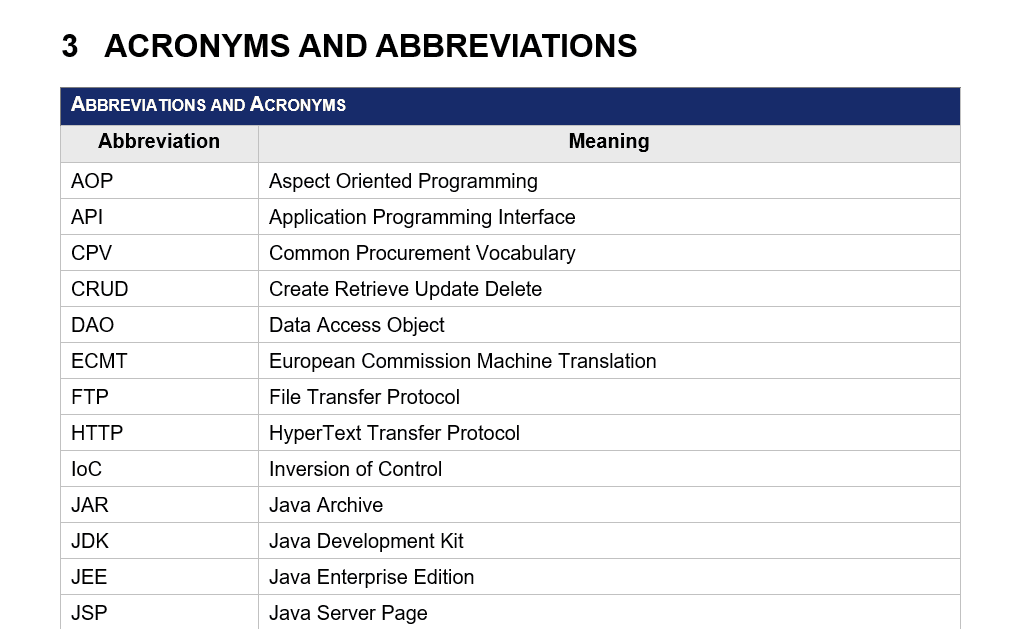
Source: eTendering
As Yegor Bugayenko of Huawei claims, having no glossary or writing a messy one is the biggest mistake in technical specifications.
“It’s not prose! It’s not a love letter! It’s technical documentation. We can’t juggle words for the sake of fun.”
So, you should choose a set of terms to use throughout the document, and list them in the glossary.
In addition to clarifying jargon, your technical specification should also explain the meaning behind the specialized terminology used in your product.
That way, all readers will be able to check the meaning whenever they find it necessary, rather than guessing it.
You can also increase the clarity of your tech spec by illustrating complex concepts with visual elements.
These don’t have to be visual masterpieces—a simple flowchart can demonstrate the relations between the components better than regular sentences.
Here’s a great example of a simple, yet effective illustration from the OAuth 2.0 specification.
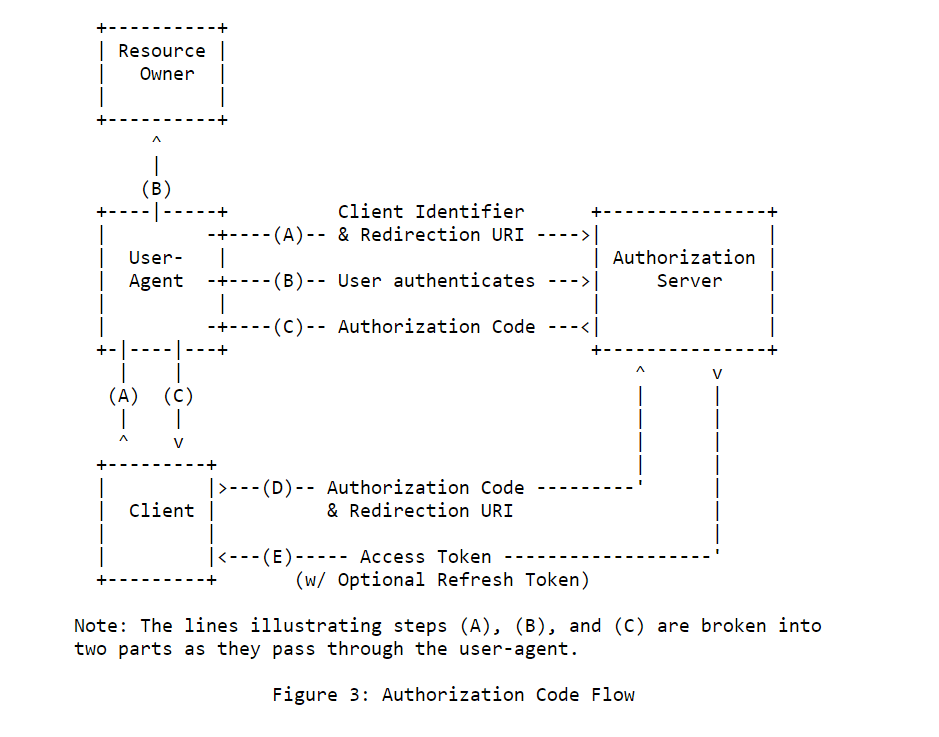
Source: IETF Datatracker
Of course, there’s no reason to refrain from implementing better-looking diagrams and images, such as those generated by Miro or Lucidchart.
Either way, flowcharts are excellent devices for portraying convoluted ideas in an accessible way.
What are the 4 types of specifications?
As you can see, writing good technical specifications boils down to writing clearly. Let's go over the four main types of specifications that are commonly used in the software development and engineering industries:
- Performance Specifications: These specify the requirements for the performance of the system or software being developed, such as speed, accuracy, and reliability.
- Design Specifications: These describe the design elements of the system or software, including the user interface, system architecture, and database design.
- Functional Specifications: These specify the features and functionalities of the system or software, including inputs, outputs, and processing requirements.
- Interface Specifications: These describe the interfaces between different components of the system or software, such as data exchange formats and communication protocols.
Conclusion
Whether you’ve envisaged a straightforward website or a complex app for your product, you shouldn’t start building the software without writing a technical specification first.
This valuable piece of documentation can point to the potential flaws in the product’s design and help you stay on track during development—but only if you organize the specification well.
So, before you start coding your next project, make sure you create its technical specification first. And, if you successfully created it, guess what, you just learned how to write a technical specification document.
If that sounds complicated, you should try out Archbee’s specification template and see how it makes the process easier.
FAQ
Frequently Asked Questions
A technical specification is your team’s single source of truth for a product or feature. It spells out what you’re building, why it matters, and how it will be implemented so engineers, product managers, and QA can move in lockstep.
A solid tech spec typically includes:
- Scope and constraints: what’s in/out, assumptions, and known limits
- Functional behavior: user flows, edge cases, and error handling
- Architecture and design: components, APIs, data models, and diagrams
- Security, privacy, and compliance: threats, controls, and requirements
- Performance and reliability targets: latency, throughput, SLOs/SLAs
- Testing and acceptance criteria: how you’ll validate it works
- Risks and dependencies: what could go wrong and how you’ll mitigate it
- Milestones and rollout plan: phases, timelines, and release strategy
- Glossary and references: shared terminology and supporting docs
In short, a tech spec covers the what and the how, turning ideas into an actionable, testable plan.
![How to Write a Technical Specification Document [examples & templates]](/_next/image?url=%2Fblogs%2Ftechnical-specification%2Fthumbnail.png&w=2048&q=75&dpl=dpl_Gns2Fm668oHB3irh7KyaPBufSMT9)